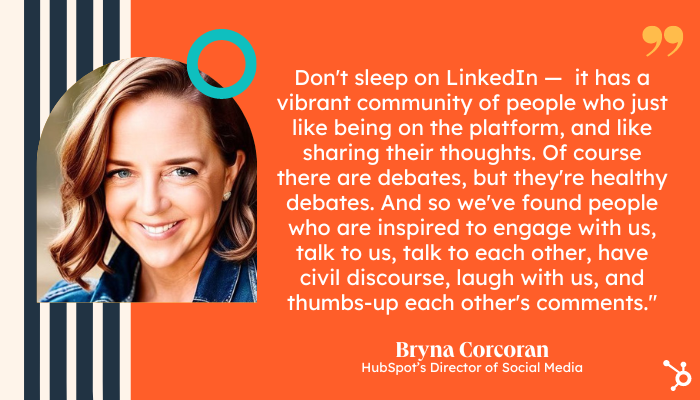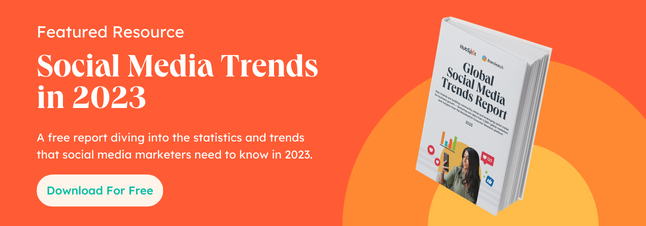Our view at Stack - Simplify growth with an all-in-one platform. Powerful marketing, sales, and support automation. Integrated CMS. Scalable software. Crafted for customer experience.
Welcome to HubSpot’s Expert Edge Series, where we interview top execs at major brands to explore their perspectives on the latest trends, challenges, and opportunities shaping the industry.
Over the past few months, you might’ve noticed a shift in HubSpot’s social strategy.
The more traditional B2B posts have given way for a social media presence that is funnier, more casual, and definitely more meme-ified.
Which led me to wonder: What’s the reason behind the shift?
![Download Now: The 2024 State of Social Media Trends [Free Report]](https://no-cache.hubspot.com/cta/default/53/3dc1dfd9-2cb4-4498-8c57-19dbb5671820.png)
As HubSpot’s Global Director of Social Media, Bryna Corcoran, told me: “About seven months ago, we started to speak to the next generation of marketing or sales reps — we started to use the Gen Z and millennial tone-of-voice. We started to dabble in internet culture; we started to post memes, which, you know, definitely got us some questionable faces. We started to make it more of a conversational community. And it’s working.”
Turns out, it’s more than just working. In the past seven months alone, HubSpot’s social team has seen 84% year-over-year growth on LinkedIn.
Here, Corcoran shares with me her tips for growing a LinkedIn community, as well as her broader insights on how to succeed across social platforms in 2024.
HubSpot’s Director of Social On Creating A Strong LinkedIn Strategy, Becoming Relevant to Gen Z, and Experimenting Constantly
LinkedIn’s Audience Has Changed: So Your Content Should, Too
When I sat down with Corcoran, the first question I asked her was simple: Why LinkedIn?
She told me there are several reasons. For one, some users have found it harder to thrive on X (previously known as Twitter), so they’ve gradually migrated to LinkedIn for that similar “open-forum town square” feel.
Additionally, more Gen Z’s and younger millennials are now turning to LinkedIn for career development and job searching.
So the social team saw an opportunity: Why not test out their Twitter tone-of-voice — short, text-only casual posts, or what she calls “shower musings” — on LinkedIn?
And it blew up.
Corcoran says, “In the beginning, we were unsure how our new strategy would perform, so we treaded lightly by posting only a few times a week. But I’m happy to report that we’re gaining followers faster than ever, and that’s because we’re taking a personal approach.”
She adds, “It’s almost like we’re turning HubSpot into a person, rather than a brand, by discussing the musings of how our customers are thinking or feeling on a daily basis as they try to grow their companies.”
LinkedIn’s Users Expect to Interact With Businesses on the Platform, So It’s a Good Platform to Lean Into
There’s another benefit to LinkedIn, too — while Instagram and Facebook are largely for personal connections, users expect to interact with businesses on LinkedIn. In fact, it’s the purpose of the channel.
In other words: Businesses aren’t breaking through quite as high of a barrier on LinkedIn when it comes to figuring out authentic ways for users to interact with them.
As Corcoran told me, “Don’t sleep on LinkedIn — It is one of the most credible platforms. To be on the platform, you need to put your real first and last name, and your work history is accurate, and you’re a reflection of the school you went to or the company you work for … so you’re much more likely to contribute thoughtfully on LinkedIn compared to other platforms.”

She continues, “So what we’ve found on LinkedIn is a vibrant community of people who just like being on the platform, and like sharing their thoughts. Of course there are debates, but they’re healthy debates. And so we’ve found people who are inspired to engage with us, talk to us, talk to each other, have civil discourse, laugh with us, and thumbs-up each other’s comments.”
One other big plus and differentiation for LinkedIn? Its ability to amplify your content to new audiences simply by engaging with the content. If Corcoran and I are connected as colleagues but I don’t follow HubSpot and she comments on or likes a HubSpot post, LinkedIn will auto-publish that interaction and post to my own feed. Which means LinkedIn provides incredible opportunities to broadcast your content to reach new prospects and leads simply through light-weight engagement.
Take an Audience-First Approach With Any Social Strategy — While Also Leaning Into Cultural Relevancy
Roughly six months ago, Corcoran and her team decided to develop new, fresh personas for their social channels to enable them to take an audience-first approach. Now, when they’re crafting a piece of social content, they’re able to keep that person top-of-mind.
For instance, one persona they’ve developed is the sales rep who is trying to get their cold calls answered. From there, it’s easier to brainstorm clever, relatable text-based thoughts that could resonate with that persona and make her feel like HubSpot understands their challenges.
Corcoran told me she also looks at cultural moments. “We look at things that people are talking about outside of the HubSpot universe. What’s top of mind for them? If we can connect to what’s going on in culture, it’s even stickier and more relatable.”
She adds, “In the beginning, there was a little bit of the ‘let’s try everything’ method, because it was uncharted. So we decided to test a lot: Does our audience gravitate to a Barbie meme? Are we rubbing people the wrong way if we lean into grammatical errors because that’s how Gen Z types?”
Now, before Corcoran’s team posts anything, they ask themselves three questions:
- Who is this for?
- What’s the HubSpot way in?
- How can we connect it to culture?
If they can strike those three things well, they typically find success. But, as Corcoran points out, they don’t crush it every time — and they’re still learning.
You Might Be Surprised By What Types of Content Performs Best With Your Audience, So Testing is Key
When HubSpot won a G2 award recently, Corcoran’s team posted a traditional, official asset to highlight the award. And it got widely shared.
But then, later that afternoon, they decided to post a meme, instead.
As Corcoran told me, “That blew up. People were really energized by the fact that we had a little bit of swag with our G2 announcement. And the more fun, personality-driven approach accomplishes the same goal for us as the more corporate-looking post: Driving awareness.”
One thing we’ve found,” She adds, “is if a post is too polished or clean on social, it gets misunderstood as an ad. So if we’re doing a video, we take a TikTok or Reels approach where it’s just 30-seconds shot on an iPhone and we put it out.”
If you work for a B2B company, it can be tempting to pigeonhole your brand on social as polished, professional, and formal. But that doesn’t necessarily have to be the case — the more you can personify your business, the easier it will be for decision-makers to connect with your brand.
Of course, what works best for one business will flop for another. So it’s equally critical you continue to test and iterate over time. At the end of each month, for instance, Corcoran and her team look at every single post and say, ‘Okay, how did this one perform? Was it short and easy-to-read? Was the graphic too corporate-y?’
As Corcoran notes, over time, you begin to notice themes. And those themes can help you get better at predicting what performs well with your audience … and what doesn’t.
(Bonus Tip: Corcoran suggests posting on LinkedIn three to four times per week; but she encourages businesses to avoid posting on the weekends, since people typically aren’t using the platform during their time off. Additionally, she’s seen the most success posting first thing in the morning, around lunchtime, or around 5-6 PM — basically, when people are waking up, when they’re taking a lunch break, or when they’re winding down after work.)
Shares Means Your Content Connected Emotionally With Your Audience
Finally, I asked Corcoran how she measures success on social. How does she know her team’s social posts are driving business impact?
Here’s how Corcoran thinks about it: “We know a Miley Cyrus meme won’t get you to purchase software, but we want you to be aware of HubSpot — that we’re present, that we’re culturally relevant — so that we’re top-of-mind when you are in the buying motion.”
She continues, “Our master goal is brand awareness and product consideration, and the way we measure brand awareness is through engagement: Whether that’s liking, commenting, or sharing.”
In particular, she told me she gets really excited about shares — because that tells her that the content connected emotionally with the user on some level. It means a user slowed down and said, ‘This is so relevant to me that I need to share it with someone else.’
Corcoran says, “Oftentimes, that person will share with someone who hasn’t heard of HubSpot, and suddenly they’re curious about us.”
With Social, Be Willing to Test the Boundaries
Ultimately, if there’s one thing I learned from Corcoran, it’s this: B2B businesses have historically played it safe when it comes to creating engaging content on social media.
But social media users’ expectations are rapidly evolving, and it’s critical your business continue to evaluate and iterate on its own social strategy to reach new audiences and drive brand awareness in 2024 and beyond.

![]()
If Hubspot is of interest and you'd like more information, please do make contact or take a look in more detail here.
Credit: Original article published here.
